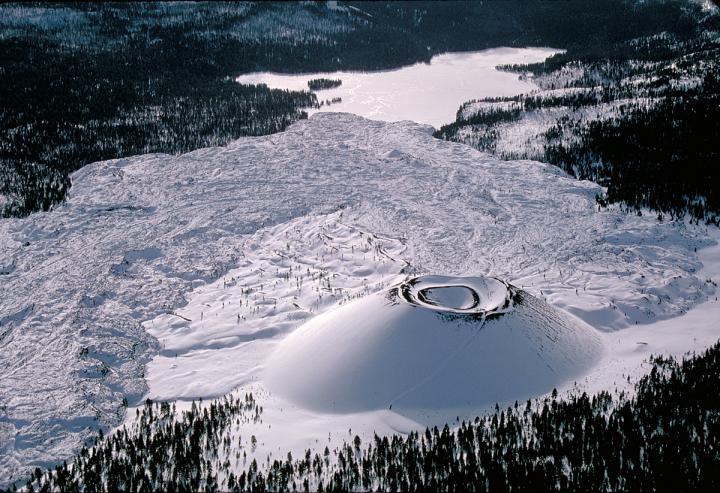Explosive volcanoes fueled by water, say Oregon researchers

A snowy cinder cone on Mount Lassen in Northern California, where University of Oregon researchers collected samples for their study on magma formation. They determined that the water cycle plays a key role in explosive volcanoes in the Cascade Range. Photo by Marli Miller, University of Oregon
University of Oregon geologists have tapped water in surface rocks to show how magma forms deep underground and produces explosive volcanoes in the Cascade Range.
“Water is a key player,” says Paul J. Wallace, a professor in the UO's Department of Geological Sciences and coauthor of a paper in the May issue of Nature Geoscience. “It's important not just for understanding how you make magma and volcanoes, but also because the big volcanoes that we have in the Cascades — like Mount Lassen and Mount St. Helens — tend to erupt explosively, in part because they have lots of water.”
A five-member team, led by UO doctoral student Kristina J. Walowski, methodically examined water and other elements contained in olivine-rich basalt samples that were gathered from cinder cone volcanoes that surround Lassen Peak in Northern California, at the southern edge of the Cascade chain.
The discovery helps solve a puzzle about plate tectonics and the Earth's deep water cycle beneath the Pacific Ring of Fire, which scientists began studying in the 1960s to understand the region's propensity for big earthquakes and explosive volcanoes. The ring stretches from New Zealand, along the eastern edge of Asia, north across the Aleutian Islands of Alaska and south along the coast of North and South America. It contains more than 75 percent of the planet's volcanoes.
To understand how water affects subduction of the oceanic plate, in which layers of different rock types sink into the mantle, the UO team studied hydrogen isotopes in water contained in tiny blobs of glass trapped in olivine crystals in basalt.
To do so, the team used equipment in Wallace's lab, CAMCOR, the Carnegie Institution in Washington, D.C., and a lab at Oregon State University. CAMCOR is UO's Advanced Materials Characterization in Oregon, a high-tech extension service located in the underground Lorry I. Lokey Laboratories.
Next, the team fed data gained from the rocks into a complex computer model developed by co-author Ikudo Wada, then of Japan's Tohoku University. She has since joined the University of Minnesota.
That combination opened a window on how rising temperatures during subduction drive water out of different parts of the subducted oceanic crust, Walowski said. Water migrates upwards and causes the top of the subducted oceanic crust to melt, producing magma beneath the Cascade volcanoes.
The key part of the study, Wallace said, involved hydrogen isotopes. “Most of the hydrogen in water contains a single proton,” he said. “But there's also a heavy isotope, deuterium, which has a neutron in addition to the proton. It is important to measure the ratio of the two isotopes. We use this ratio as a thermometer, or probe, to study what's happening deep inside the earth.”
“Melting of the subducting oceanic crust and the mantle rock above it would not be possible without the addition of water,” Walowski said. “Once the melts reach the surface, the water can directly affect the explosiveness of magma. However, evidence for this information is lost to the atmosphere during violent eruptions.”
###
The National Science Foundation (grant EAR-1119224) and Carnegie Institution supported the research. Other coauthors were E.H. Hauri of the Carnegie Institution and M.A. Clynne of the U.S. Geological Survey.
Sources: Paul Wallace, professor of geosciences, 541-346-5985, pwallace@uoregon.edu, and Kristina Walowski, graduate teaching fellow, Department of Geological Sciences, walowski@uoregon.edu
Note: The UO is equipped with an on-campus television studio with a point-of-origin Vyvx connection, which provides broadcast-quality video to networks via a fiber optic network. In addition, there is video access to satellite uplink, and audio access to an ISDN codec for broadcast-quality radio interviews.
Links:
Paper: http://www.
About Walowski: http://geology.
About Wallace: http://geology.
Department of Geological Sciences: http://geology.
Ars Technica coverage: http://arstechnica.
Media Contact
All latest news from the category: Earth Sciences
Earth Sciences (also referred to as Geosciences), which deals with basic issues surrounding our planet, plays a vital role in the area of energy and raw materials supply.
Earth Sciences comprises subjects such as geology, geography, geological informatics, paleontology, mineralogy, petrography, crystallography, geophysics, geodesy, glaciology, cartography, photogrammetry, meteorology and seismology, early-warning systems, earthquake research and polar research.
Newest articles

NASA: Mystery of life’s handedness deepens
The mystery of why life uses molecules with specific orientations has deepened with a NASA-funded discovery that RNA — a key molecule thought to have potentially held the instructions for…

What are the effects of historic lithium mining on water quality?
Study reveals low levels of common contaminants but high levels of other elements in waters associated with an abandoned lithium mine. Lithium ore and mining waste from a historic lithium…

Quantum-inspired design boosts efficiency of heat-to-electricity conversion
Rice engineers take unconventional route to improving thermophotovoltaic systems. Researchers at Rice University have found a new way to improve a key element of thermophotovoltaic (TPV) systems, which convert heat…



